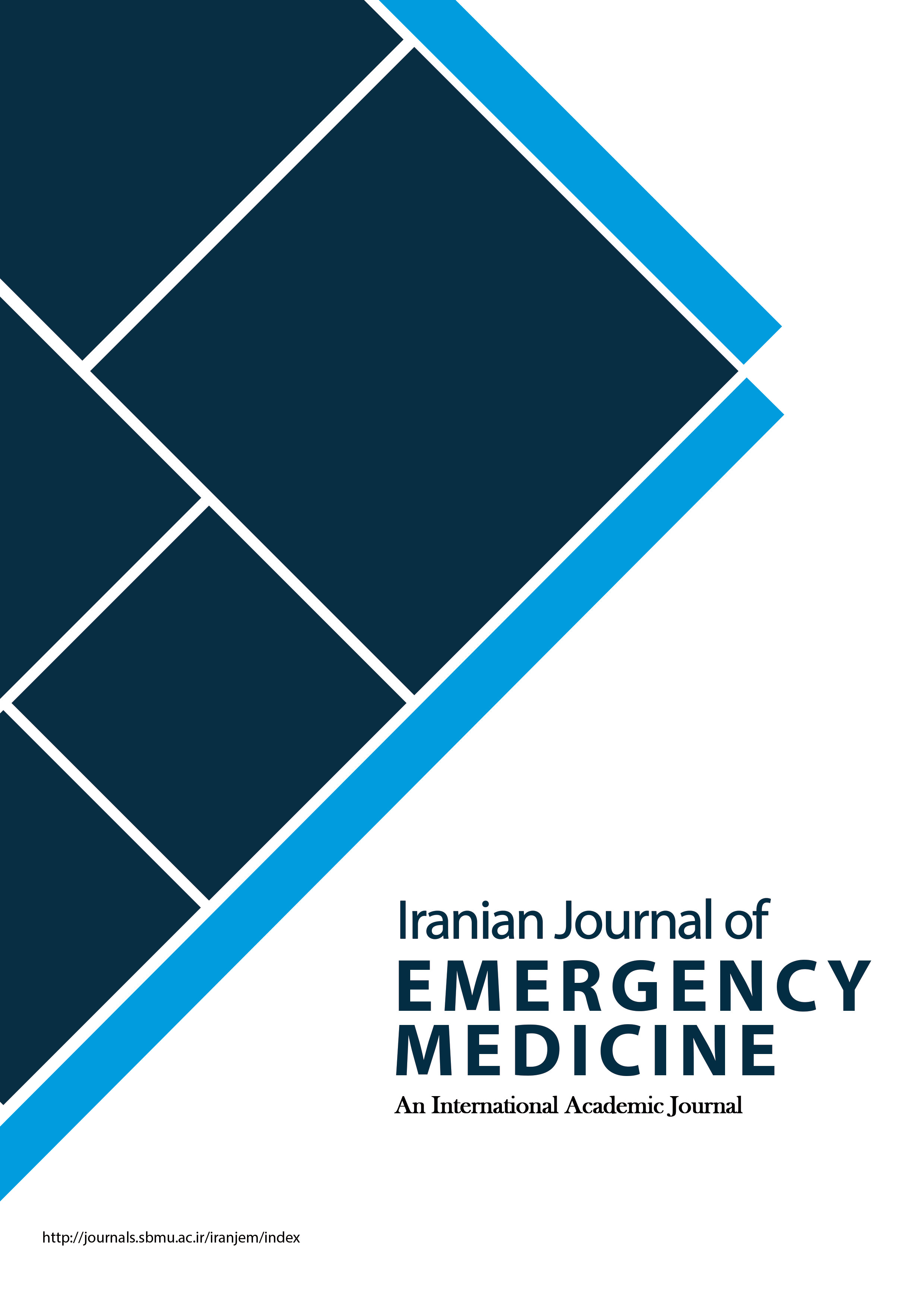A Survey on the Status of Job burnout among pre-hospital emergency personnel in Shahroud
Iranian Journal of Emergency Medicine,
Vol. 6 No. 1 (2019),
23 February 2019
,
Page e11
https://doi.org/10.22037/ijem.v6i1.25902
Abstract
Introduction: Job burnout is a disorder due to long-term exposure of a person to work-related stress. The aim of this study was to investigate the burnout status of pre-hospital emergency staff in Shahroud city. Methods: This cross-sectional study was carried out on 100 pre-hospital emergency staff in Shahroud, Iran in 1397. The Maslach Burnout Questionnaire was used. For data analysis, descriptive statistics, mean and standard deviation, and independent t-test, Chi-square and Fisher exact tests were used based on the type of variable. The significance level was considered as 0/05. Results: In this study, 100 cases (all were male) were included. The mean age was 30.75±5.55 years. The severity and frequency of emotional exhaustion were low in 95% of subjects. Depersonalization in frequency was high in 45% of the cases and was high in severity in 50% of the subjects. Personality satisfaction was moderate in frequency in 40% of the cases and was low in severity in 65 percent. Conclusion: The results of this study showed that pre-hospital emergency staff had mild degrees of severity and frequency of emotional exhaustion and moderate degrees of severity and frequency of personal adequacy and sever feeling of personality deprivation.
- Emergency
- burnout
- Shahroud
How to Cite
References
Vaziri S, Mohammadi F, Mosaddegh R, Masoumi G, Noyani A, Bahadormanesh A. Prevalence and Causes of Job Burnout Syndrome among Emergency Medicine Residents of Iran University of Medical Sciences. Iranian Journal of Emergency Medicine. 2016;5:10.
Leiter MP, ARNOLD BB. The contemporary context of job burnout. Burnout at work: Psychology Press; 2014. p. 9-17.
Wessells Jr D, Kutscher A, Seeland IB, Selder FE, Cherico DJ, Clark EJ. Professional burnout in medicine and the helping professions: Routledge; 2013.
Arora M, Diwan AD, Harris IA. Burnout in orthopaedic surgeons: a review. ANZ J Surg. 2013;83(7-8):512-5.
Maunz S, Steyrer J. [Burnout syndrome in nursing: etiology, complications, prevention]. Wien Klin Wochenschr. 2001;113(7-8):296-300.
Emold C, Schneider N, Meller I, Yagil Y. Communication skills, working environment and burnout among oncology nurses. European Journal of Oncology Nursing. 2011;15(4):358-63.
Naude JL, Rothmann S. The validation of the Maslach Burnout Inventory-Human Services Survey for emergency medical technicians in Gauteng. SA Journal of Industrial Psychology. 2004;30(3):21-8.
Kowalski KM, Vaught C. The safety and health of emergency workers. Journal of Contingencies and Crisis Management. 2001;9(3):138-43.
Aronsson G. Contingent workers and health and safety. Work, employment and society. 1999;13(3):439-59.
Moradi Z, Eslami AA, Hasanzadeh A. Job burnout status among pre-hospital emergency technicians. Iranian journal of emergency medicine. 2015;2(1):28-32.
MOTIE MR, Kalani M, SAMADI A, ESHAGHI H, Ghobadi P. Prevalence of job stressorsin male pre-hospital emergency technicians. 2010.
Khazaei I, Khazaee T, SHARIFZADEH GR. NURSES'PROFESSIONAL BURNOUT AND SOME PREDISPOSING FACTORS. 2006.
Maslach C, Jackson SE. The measurement of experienced burnout. Journal of organizational behavior. 1981;2(2):99-113.
MOUMENI H, Salehi A, SERAJI A. The comparison of burnout in nurses working in clinical and educational sections of Arak University of Medical Sciences in 2008. 2010.
Atef L, Roholamin M, Nori A, Molavi H. [Burnout and job satisfaction, general surgeons and experts in Isfahan]. Knowledge and Research in Applied Psychology. 2006;8(29):129-51.
Seyed Javadin S, Shahbaz Moradi S. Job burnout: A study in haffar naft-e jonoub company. Quarterly Iranian Journal Of Management Sciences. 2006;1(2).
Zhang LF, You LM, Liu K, Zheng J, Fang JB, Lu MM, et al. The association of Chinese hospital work environment with nurse burnout, job satisfaction, and intention to leave. Nurs Outlook. 2014;62(2):128-37.
Ogresta J, Rusac S, Zorec L. Relation between burnout syndrome and job satisfaction among mental health workers. Croatian medical journal. 2008;49(3):364-74.
Kaviani H, Khaghanizade M. The relationship between burnout and mental health among nurses. Tehran University Medical Journal TUMS Publications. 2007;65(6):65-75.
Harkin M, Melby V. Comparing burnout in emergency nurses and medical nurses. Clinical Nursing Studies. 2014;2(3):152-63.
França SPdS, De Martino MMF, Aniceto EVdS, Silva LL. Predictors of Burnout Syndrome in nurses in the prehospital emergency services. Acta Paulista de Enfermagem. 2012;25(1):68-73.
Talaei A, Mokhber N, Mohammad–Nejad M, Samari A. Burnout and its related factors in staffs of university hospitals in Mashhad in 2006. Koomesh. 2008;9(3):237-46.
ABDI MF, KAVIANI H, Khaghanizadeh M, MOMENI AA. The relationship between burnout and mental health among nurses. 2007.
Abdi F, Khaghanizade M, Sirati M. Determination of the amount Burnout in Nursing Staff. J Behav Sci. 2008;2(1):51-9.
Zeighami Mohammadi S, Asgharzadeh Haghighi S. Relation between Job Stress and Burnout among Nursing Staff. J Hamedan Nurs Midwif Sch. 2011;19(2):42-52.
M. D, Raeissi P, Begdeli F, Shahabi M. The impact of job rotation on nurses burnout in Ayatollah Kashani hospital, Tehran: A case study. Iran Occup Health. 2011;7(4):2-0.
- Abstract Viewed: 451 times
- PDF (فارسی) Downloaded: 193 times
- HTML (فارسی) Downloaded: 66 times



